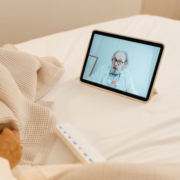In a single academic medical center study, implementation of a teleICU intervention was associated with reduced adjusted odds of mortality and reduced hospital length of stay, as well as with changes in best practice adherence and lower rates of preventable complications
Tele-ICU improves patient safety, mortality and length of stay. This effect is enhanced by continuous and proactive monitoring over episodic involvement, frequent performance reviews as well as close integration of the tele-ICU team with existing bedside team structures. Tele-ICU with added logistics functions has the potential to optimize ICU bed utilization and enhance financial performance
A tele-intensive care unit (tele-ICU) uses telemedicine in an intensive care unit (ICU) setting, applying technology to provide care to critically ill patients by off-site clinical resources… Intensivists working these systems are able to more effectively treat ICU patients, providing better clinical outcomes for patients at lower costs compared with hospitals without a tele-ICU
…an increasing number of studies have shown that intensivist-staffed intensive care units (ICUs) lead to overall economic benefits and improved patient outcomes, including shorter length of stay and lower rates of complications and mortality… This article explores the history of intensivists and critical care, the arguments for 24/7 ICU staffing, and outcomes in various ICU settings
Tele-ICUs may serve within a hybrid model of care to support high-intensity coverage and bridge the gap for nocturnal ICU care. Tele-ICU is associated with improved ICU mortality and decreased LOS, albeit with significant heterogeneity among studies. It also has the potential for additional benefits, such as enhancing cardiovascular critical care, reducing interhospital transfers and improving staff satisfaction
A common theme is improvement in access to critical care services and consistent delivery of high-quality care. The improved quality extends beyond ICU mortality and length-of-stay metrics to implementation and adherence to specific best-practice protocols; supporting the teams at bedside; and the ability to bring structure, standardization, and collaboration to units
The ability of properly modified ICU telemedicine programs to increase case volume and access to high-quality critical care with improved annual direct contribution margins suggests that there is a financial argument to encourage the wider adoption of ICU telemedicine
Technology-enabled remote care can be used to provide continuous ICU patient management and to achieve improved clinical and economic outcomes. This intervention’s success suggests that remote care programs may provide a means of improving quality of care and reducing costs when on-site intensivist coverage is not available
The addition of a supplemental, telemedicine-based, remote intensivist program was associated with improved clinical outcomes and hospital financial performance… telemedicine may provide a means for hospitals to achieve quality improvements associated with intensivist care using fewer intensivists.
In the absence of a defined insurer reimbursement model for care delivery, revenue sources for a tele-ICU system depend entirely on the organizational structure of the system/network and variable contractual relationships between entities. A few different revenue models appear to currently exist.











